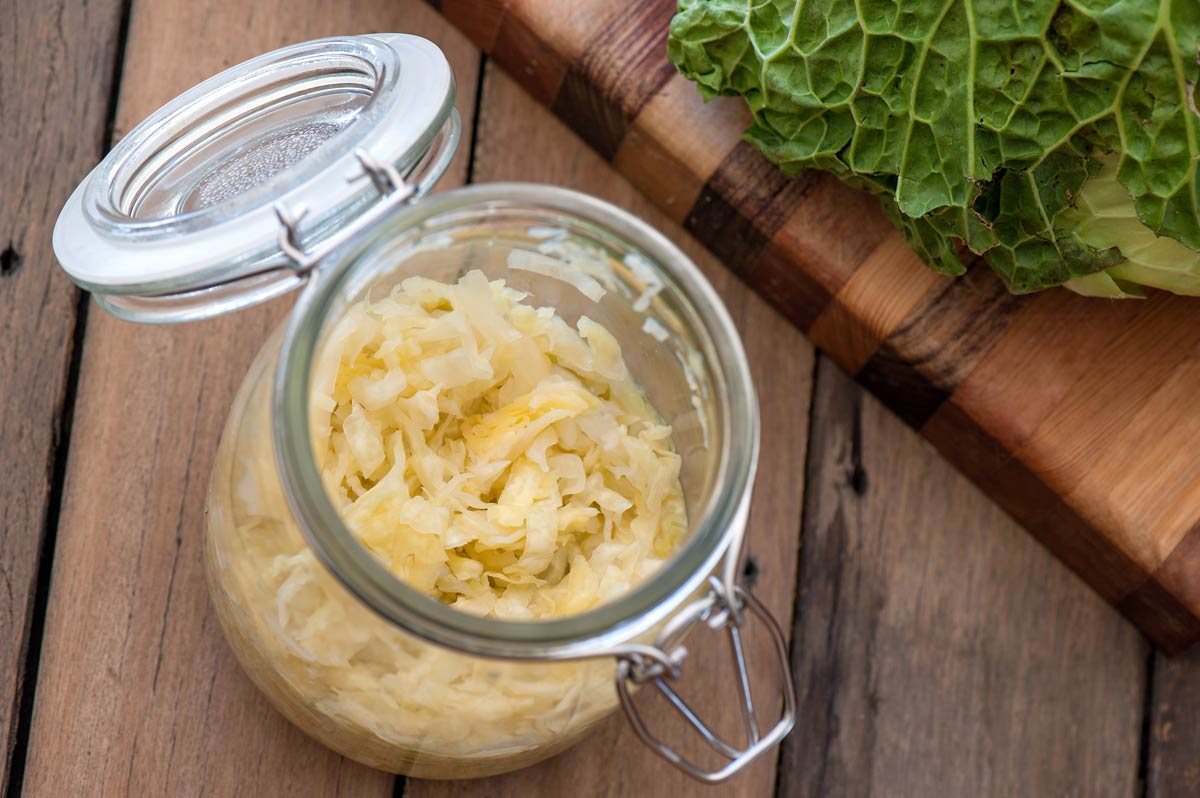 Photo by Jules Clancy, thestonesoup.com. Portrait by Neil White
Photo by Jules Clancy, thestonesoup.com. Portrait by Neil White

Food Hunt: how to make your own Sauerkraut and what to do with it
Chef Tom Hunt says that one way of preserving your autumn cabbage glut is an acquired taste that’s well worth acquiring.
Sauerkraut is one of the simplest, most affordable and nutritious things in the world we can make and consists of just two ingredients, cabbage and salt. A controlled fermentation process allows ‘good’ bacteria, mainly lactobacillus (related to those used to make cheese and yoghurt) to multiply, dominate over ‘bad’ microorganisms and so preserve the food.
Research has found that consuming bacteria in pre and probiotic food is beneficial for good health and supports everything from our digestion of other foods to our mood. Lacto fermented foods are also delicious and are often considered to be part of a country's national heritage. As well as sauerkraut ingredients like, olives, kimchi, yoghurt, chocolate and kombucha are also fermented.
Learn to ferment at Family Fermenting Fun, taking place during Urban Food Fortnight
Sauer power
To make sauerkraut, finely cut a red or white cabbage, season generously with salt, then mix well. Bruise the cabbage, massaging the salt into it until the juices begin to run. Taste the cabbage and adjust the seasoning if necessary, it should taste well-seasoned, but delicious and perfectly edible. Now pack the cabbage into a large sterilised pickling jar, or several smaller ones, pushing it down firmly as you go. When the jars are full, squash the cabbage down. The liquid drawn out by the salt and bruising should rise above the cabbage, if it doesn’t add a drop of filtered or boiled water to bring the level up above the surface. Place a lid loosely on the jar or jars and leave at room temperature for a minimum of two to three days. When the sauerkraut begins to bubble and tastes slightly acidic and funky it is ready! At this point you can seal the jars and either continue to ferment the sauerkraut at room temperature for months or even years, or put it in the fridge to halt the fermentation. If you are new to making sauerkraut I recommend you put one jar in the fridge and keep another out. Taste the sauerkraut as it ferments and take note of the different flavours.
Win tickets to see fermentation guru and author, Sandor Katz by joining London Food Link before Monday 16th September.
Five ways with sauerkraut
- As a condiment with any meal! Yes, I love it that much
- In an omelette with lovage or chopped fresh dill, or with fried eggs
- On top of a rice bowl, bibimbap or chirashi
- Add the brine or sauerkraut itself to a soup or stew for acidity, saltiness and a savoury umami kick
- Fry in a pan with chopped apple and smoked paprika to serve on toast
Chef’s tip
Sauerkraut is traditionally made with cabbage, however any vegetable can be sliced or grated and made in the same way. Also try flavouring with ingredients like caraway seeds or dill.
Make the most of your produce with chef Tom Hunt’s tips in our continuing Food Hunt series, including Summer’s Seasonal Softies, and Fairtrade Food Hunt
This feature first appeared in The Jellied Eel magazine issue 55, September 2017
London Food Link: London Food Link brings together community food enterprises and projects that are working to make good food accessible to everyone in London to help create a healthy, sustainable and ethical food system for all.
Sustain
The Green House
244-254 Cambridge Heath Road
London E2 9DA
020 3559 6777
sustain@sustainweb.org
Sustain advocates food and agriculture policies and practices that enhance the health and welfare of people and animals, improve the working and living environment, promote equity and enrich society and culture.
© Sustain 2025
Registered charity (no. 1018643)
Data privacy & cookies
Icons by Icons8